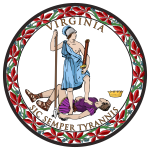| Elections in Virginia |
|---|
 |
Virginia elected its members April 30, 1827, after the term began but before the new Congress convened.
| District | Incumbent | This race | |||
|---|---|---|---|---|---|
| Member | Party | First elected | Results | Candidates | |
| Virginia 1 | Thomas Newton Jr. | Anti-Jacksonian | 1801 | Incumbent re-elected. |
|
| Virginia 2 | James Trezvant | Jacksonian | 1825 | Incumbent re-elected. |
|
| Virginia 3 | William S. Archer | Jacksonian | 1820 (Special) | Incumbent re-elected. |
|
| Virginia 4 | Mark Alexander | Jacksonian | 1819 | Incumbent re-elected. |
|
| Virginia 5 | George W. Crump | Jacksonian | 1826 (Special) | Incumbent retired. New member elected. Jacksonian hold. |
|
| Virginia 6 | Thomas Davenport | Jacksonian | 1825 | Incumbent re-elected. |
|
| Virginia 7 | Nathaniel H. Claiborne | Jacksonian | 1825 | Incumbent re-elected. |
|
| Virginia 8 | Burwell Bassett | Jacksonian | 1805 1812 (Lost) 1815 1819 (Retired) 1821 | Incumbent re-elected. |
|
| Virginia 9 | Andrew Stevenson | Jacksonian | 1821 | Incumbent re-elected. |
|
| Virginia 10 | William C. Rives | Jacksonian | 1823 | Incumbent re-elected. |
|
| Virginia 11 | Robert Taylor | Anti-Jacksonian | 1825 | Incumbent retired. New member elected. Jacksonian gain. |
|
| Virginia 12 | Robert S. Garnett | Jacksonian | 1817 | Incumbent retired. New member elected. Jacksonian hold. |
|
| Virginia 13 | John Taliaferro | Anti-Jacksonian | 1801 1803 (Retired) 1811 (Challenge) 1813 (Lost) 1824 (Special) | Incumbent re-elected. |
|
| Virginia 14 | Charles F. Mercer | Anti-Jacksonian | 1817 | Incumbent re-elected. |
|
| Virginia 15 | John S. Barbour | Jacksonian | 1823 | Incumbent re-elected. |
|
| Virginia 16 | William Armstrong | Anti-Jacksonian | 1825 | Incumbent re-elected. |
|
| Virginia 17 | Alfred H. Powell | Anti-Jacksonian | 1825 | Incumbent lost re-election. New member elected. Jacksonian gain. |
|
| Virginia 18 | Joseph Johnson | Jacksonian | 1823 | Incumbent lost re-election. New member elected. Anti-Jacksonian gain. |
|
| Virginia 19 | William McCoy | Jacksonian | 1811 | Incumbent re-elected. |
|
| Virginia 20 | John Floyd | Jacksonian | 1817 | Incumbent re-elected. |
|
| Virginia 21 | William Smith | Jacksonian | 1821 | Incumbent retired. New member elected. Anti-Jacksonian gain. |
|
| Virginia 22 | Benjamin Estil | Anti-Jacksonian | 1825 | Incumbent retired. New member elected. Jacksonian gain. |
|













